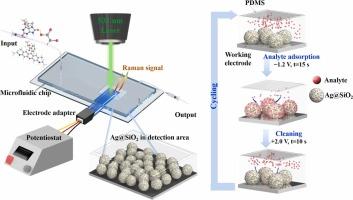集成微流控动态电位调制SERS芯片,具有高灵敏度和自清洁功能
IF 3.7
1区 化学
Q1 CHEMISTRY, ANALYTICAL
引用次数: 0
摘要
表面增强拉曼散射(SERS)技术在实际应用中面临着一些挑战,包括灵敏度低、基片不可逆污染导致循环稳定性差,以及难以实现复杂检测过程的集成。为了解决这些挑战,我们提出了一种带有动态电位调制的微流体- sers集成检测芯片,实现了完整的“检测-自清洁-再检测”闭环操作。首先,采用化学还原法制备高灵敏度核壳Ag@SiO2底物,对罗丹明6 G (R6G) (AEF = 5.7 × 109)的检出限为10−12 mol/L。然后将等离子体表面清洗应用于聚二甲基硅氧烷(PDMS)微流控通道与丝网印刷电极(spe)的结合,从而构建了具有动态电位调制的微流控sers芯片。通过施加正电位(+2.0 V/10 s),靶分子从SERS衬底上的金属纳米颗粒间隙中解吸,形成一定厚度的亚稳金属氧化物层。随后,施加负电位(- 1.2 V/15 s)去除部分金属氧化物层,实现拉曼热点的原位再生,快速驱动探针分子富集。经过8个周期的检测,信号强度仍然很高。此外,该平台可以精确识别多分子混合物(R6G/CV/MG),并已成功应用于尿酸分子的检测。其现场检测能力在便携式系统中得到进一步验证,为复杂的现实环境中的快速检测提供了创新的解决方案。本文章由计算机程序翻译,如有差异,请以英文原文为准。

Integrated microfluidic dynamic potential-modulated SERS chip with high sensitivity and self-cleaning
Surface-enhanced Raman scattering (SERS) technology faces several challenges in real-world applications, including low sensitivity, irreversible contamination of the substrate leading to poor cyclic stability, and difficulties in achieving integration of complex detection processes. To address these challenges, we propose a microfluidic-SERS integrated detection chip with dynamic potential modulation, enabling a complete “detection–self-cleaning–re-detection” closed-loop operation. Firstly, a high-sensitivity core-shell Ag@SiO2 substrate was prepared using chemical reduction, achieving a detection limit of 10−12 mol/L for Rhodamine 6 G (R6G) (AEF = 5.7 × 109). Plasma surface cleaning was then applied to bond polydimethylsiloxane (PDMS) microfluidic channels with screen-printed electrodes (SPEs), resulting in the construction of a microfluidic-SERS chip with dynamic potential modulation. By applying a positive potential (+2.0 V/10 s), target molecules were desorbed from the metal nanoparticle gaps on the SERS substrate, and a metastable metal oxide layer of a certain thickness was formed. Subsequently, a negative potential (−1.2 V/15 s) was applied to remove part of the metal oxide layer, realizing in-situ regeneration of Raman hotspots and rapidly driving probe molecule enrichment. After eight cycles of detection, the signal strength remained high. Additionally, this platform can precisely identify multi-molecule mixtures (R6G/CV/MG) and has been successfully applied to the detection of uric acid molecules. Its on-site detection capability was further validated in a portable system, providing an innovative solution for rapid detection in complex real-world environments.
求助全文
通过发布文献求助,成功后即可免费获取论文全文。
去求助
来源期刊

Sensors and Actuators B: Chemical
工程技术-电化学
CiteScore
14.60
自引率
11.90%
发文量
1776
审稿时长
3.2 months
期刊介绍:
Sensors & Actuators, B: Chemical is an international journal focused on the research and development of chemical transducers. It covers chemical sensors and biosensors, chemical actuators, and analytical microsystems. The journal is interdisciplinary, aiming to publish original works showcasing substantial advancements beyond the current state of the art in these fields, with practical applicability to solving meaningful analytical problems. Review articles are accepted by invitation from an Editor of the journal.
 求助内容:
求助内容: 应助结果提醒方式:
应助结果提醒方式:


